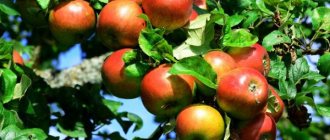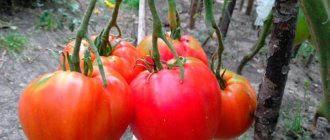Description of the variety
The early ripening potato variety Empress was bred by Russian breeders. These are unpretentious table potatoes . The variety is loved by many summer residents for its unpretentiousness and early ripening.
Origin and development
The originator of the variety is Moscow . The Empress is not included in the State Register and is not zoned. Potatoes are grown from botanical seeds.
Chemical composition, trace elements and vitamins
Potatoes are grown both for private consumption and on an industrial scale.
The calorie content of raw potatoes is 77 kcal per 100 g.
The nutritional value:
- proteins – 2 g;
- fats – 0.4 g;
- carbohydrates – 16.3 g;
- dietary fiber – 1.4 g;
- water – 79 g.
Potatoes are rich in vitamins B6, C, macro- and microelements: potassium, silicon, cobalt, copper, molybdenum, chromium.
What are the beneficial substances contained in potatoes?:
- Vitamin B6 improves metabolism and regulates the content of elements in the blood. Symptoms of vitamin B6 deficiency include decreased appetite and dull skin.
- Vitamin C helps the absorption of iron and participates in redox reactions. Lack of vitamin leads to frequent bleeding.
- Potassium normalizes blood pressure. Takes part in regulating water, acid and electrolyte balance.
- Copper helps in the absorption of proteins and carbohydrates and is involved in iron metabolism. Due to copper, the tissues of the human body are enriched with oxygen. If the amount of the element in the body is insufficient, the functioning of the cardiovascular system is disrupted.
Characteristics of tubers, description of appearance and yield
The tubers have a regular oval shape, yellow flesh and yellow skin . The eyes are not pronounced, which gives the tubers a neat appearance. On average, one potato weighs 70-150 g.
The bush is low, compact, 50 cm high. When planting, it is recommended to maintain a distance between plants of 10-15 cm. The underground part develops well, long, strong root sprouts are formed, on which tubers are formed.
The variety is early ripening. After 2.5 months the first harvest is harvested . One bush produces approximately 8 tubers. The total yield is 300-400 centners per hectare.
History of the Empress potato
The variety appeared simultaneously with a trend that arose among gardeners to renew seed potatoes with mini-tubers obtained from botanical seeds. Empress is distributed wholesale and retail by Moscow agro. The same company produces potato seeds in bags: Lada, Ilona, Deva, Assol, Triumph, Farmer, etc.
Invites us to grow potatoes from seeds
The Empress is not listed in the State Register of Plants, is not zoned for any region, and is intended for amateur cultivation . Many reviews have already been written on the forums about the listed varieties. Almost all posts are devoted to a labor-intensive experiment and disappointment with the results. Only a few managed to taste the large and crumbly tubers.
I myself am conducting the same experiment - growing Lada, Ilona and Empress from botanical seeds. The experiment has been going on for three years now. During this time, I managed to grow and eat only two large potatoes from a packet of Empress seeds. And yes! They were delicious.
Advantages and disadvantages of the variety
Before growing Empress potatoes, consider all the pros and cons of this variety.
Advantages:
- excellent taste;
- resistance to scab, late blight and nematode;
- double harvest;
- compactness of the bush.
Flaws:
- labor-intensive cultivation;
- low seed germination;
- The seedlings stretch out greatly and lie even on the sunniest windows - additional lighting is required.
Features of planting and growing
Sowing potatoes with botanical seeds begins in early April using the seedling method. The advantage of this method is that the end result is a clean crop free of diseases and viruses .
Seeds for sowing are bought in specialized stores or prepared independently from bulbs that form after potato flowering.
Preparing for landing
Growing potatoes by seeds begins with seedlings .
In the case of direct sowing of seeds into the soil, small tubers will be obtained, suitable only for further propagation. Seeds are prepared in advance :
- In the last days of March, seeds are laid for germination - a damp cloth with seeds is placed in a plastic container.
- Close the container and send it to a warm place near the battery.
- Open the container every day for a few minutes to ventilate.
- If necessary, spray with water - the seeds should be moderately moist.
After the seeds germinate , they are planted in a seedling container filled with nutrient soil.
Important! Seeds are planted in loose soil. Adding sand is not recommended.
Before sowing, the soil is compacted and moistened . After sowing, moisten again with a spray bottle with warm water and place in a warm, sunny place. The seedlings are watered and loosened as needed, and fertilized with complex fertilizer for seedlings.
After a few days, the first shoots appear. And after a month, the seedlings are ready for planting in open ground.
Dates, scheme and rules of planting
Seedlings are planted in open ground from the beginning of May , when the ground has already warmed up.
Soil preparation:
- for planting, choose a place where nightshades did not grow last year in order to avoid contamination of seedlings with diseases and viruses from the soil;
- in the fall they dig up the soil and add organic fertilizers;
- in the spring, add ash and complex fertilizer for potatoes, “Fertika”, “Ogorodnik”.
Since the Empress forms small, compact bushes , row spacing is 40-50 cm, and between plants - 10-15 cm.
Rules for planting potato seedlings :
- when planting, bury the shoot, leaving only the top leaves on the surface;
- carefully lay the long stems at an angle and cover them with earth so that they do not break;
- after planting, water the bed;
- organize a greenhouse to protect plants from frost, pests and sunburn.
The covering material is removed when the seedlings are fully established and the threat of night frosts disappears.
Features of cultivation
Growing potatoes from seeds significantly increases the yield and quality of tubers.
The first crop (mini-tubers) grown from seeds is called the first generation. It has a pronounced taste. In the first year, there is little harvest suitable for food. Basically, all tubers are left for seed and planted in the second year.
Attention! Potato tops begin to grow at +5°C, the optimal temperature for development is +18°C...+25°C. The culture is afraid of low temperatures; at -1°C the above-ground part turns black and dies.
Growing Empress potatoes requires:
- frequent loosening;
- timely watering;
- hilling;
- breaking the crust that forms on the soil after rain;
- frequent weeding;
- spraying;
- fertilizing
Watering mode
Empress needs to be watered during dry periods . Abundant watering is required during budding and flowering.
Top dressing
If the plants turn yellow and grow slowly, they are fed with liquid complex fertilizer - Kemira granules are diluted in water and watered on the potatoes. This saturates the soil with nitrogen, potassium and phosphorus.
During the period of bud formation, add a solution of 1 tbsp. l. potassium sulfate and 3 tbsp. l. ash in 10 liters of water - 500 ml per plant. During flowering, dissolve 2 tbsp in a bucket of water. l. superphosphate and cow manure and water 500 ml per bush.
Disease and pest control
Potato Empress is resistant to:
- potato nematode;
- fungal diseases;
- common scab.
When the Colorado potato beetle appears, the bushes are treated with a special preparation “Aktara”, and to prevent late blight - “Fitosporin”.
Over time, the tubers accumulate diseases , and yields begin to decline. This serves as a reason to update the seed material.
Difficulties in growing
Empress seed tubers cannot be found for sale; they are not even in the SeDek catalogue. You will have to buy botanical seeds in bags and grow them in seedlings.
Difficulties arise already at the stage of growing seedlings:
- half of the seeds do not germinate;
- many of those that have sprouted begin to darken at the roots and die;
- the seedlings are stretching too thin.
Caring for seedlings, watering and installing an additional light source will help solve problems.
Reasons for the slow development of the Empress in open ground:
- violation of crop rotation rules;
- not enough fertilizer has been applied;
- plants are damaged by frost;
- not enough loosening;
- a lot of weeds;
- the appearance of pests and diseases.
Potato care
As soon as the soil begins to dry out, feed the plant with water. This is especially important during the flowering period. Feed with manure, bird droppings, and weeds. Spud up. The variety, being quite unpretentious, does not require any special effort and grows well on its own. But, if the fruits are grown for sale, you need to apply techniques using agricultural technology. Then you are guaranteed to get a high yield of marketable potatoes.
After the hilling procedure, you can begin weed control using chemicals - but strictly two days before the first shoots. Use a proven product that destroys annual, perennial, and dicotyledonous weeds. Neon-99 and Remus are best suited - 250 liters per hectare.
During the budding period, the plant needs special watering, with the addition of fertilizers. Hilling and loosening of the soil is carried out three times per season. Such processes ensure the flow of air into the rhizome and increase the intensity of club formation.
Before digging potatoes, mow the tops. After digging up the tubers, dry them in a well-ventilated room, but avoid direct exposure to sunlight. Before being sent for storage, the crop is chemically treated.
Harvest and storage
To prevent the tubers from starting to wither and get sick, as well as to preserve good seed when storing, a number of rules must be followed .
Important! To withstand long-term winter storage, the tubers must be ripe and have a thick skin.
How and when to collect
The Empress harvest is carried out in two stages :
- For consumption - in mid-summer, about 2 months after planting. Carefully dig up the bush, take out the ripe tubers, and sprinkle the roots with soil.
- For storage - in the fall, at the end of September - beginning of October.
Storage features and keeping quality of the variety
Before storing the potatoes, dry them well and ventilate them . Potatoes must be stored in a dark place at a temperature of +3°C. A basement or cellar is used for these purposes.
The variety has good shelf life during winter storage and retains excellent taste until spring.
Reviews of the Empress variety
Many gardeners experiment with growing this variety and share their feedback.
Olga, Sosnovy Bor : “I accidentally saw a description of the Empress potato variety and a photo of compact bushes, and decided to plant it, since the garden is small. The potatoes grow very even and beautiful, but voids are formed, although only slightly. More resistant to scab than Adretta.”
Mark, Samara : “I grew the early ripening Empress variety from seeds. Of course, this is not an easy matter. First, I germinated the seeds and planted them in seedling boxes, just like tomatoes. At the end of April, I planted seedlings in box beds in the greenhouse, then transferred the seedlings to open ground. The care is normal. In the first season I collected all the tubers, even small ones. It is very important to save the seed until spring. This year I planted potatoes, planting 4-5 per hole at a time. The result justified all my efforts. We managed to collect a 10-liter bucket of excellent potatoes from three bushes.”
Video
We offer you to watch several videos in which amateur gardeners share their recommendations for growing the hybrid tea rose “Empress Farah”:
About the author:
Found a mistake? Select the text with the mouse and click:
Ctrl + Enter
Do you know that:
Tomatoes have no natural protection against late blight. If late blight attacks, any tomatoes (and potatoes too) die, no matter what is said in the description of the varieties (“variety resistant to late blight” is just a marketing ploy).










